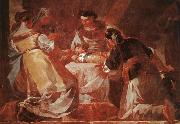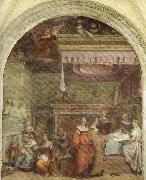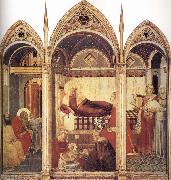
Oil On
Canvas, Real Flavor of Old Masters
|
Francisco de Goya
|
|||
|
|
|||
| Spanish 1746-1828 Francisco de Goya Locations was an Aragonese Spanish painter and printmaker. Goya was a court painter to the Spanish Crown and a chronicler of history. He has been regarded both as the last of the Old Masters and as the first of the moderns. The subversive and subjective element in his art, as well as his bold handling of paint, provided a model for the work of later generations of artists, notably Manet and Picasso. Goya married Bayeu's sister Josefa in July 25, 1773. His marriage to Josefa (he nicknamed her "Pepa"), and Francisco Bayeu's membership of the Royal Academy of Fine Art (from the year 1765) helped him to procure work with the Royal Tapestry Workshop. There, over the course of five years, he designed some 42 patterns, many of which were used to decorate (and insulate) the bare stone walls of El Escorial and the Palacio Real de El Pardo, the newly built residences of the Spanish monarchs. This brought his artistic talents to the attention of the Spanish monarchs who later would give him access to the royal court. He also painted a canvas for the altar of the Church of San Francisco El Grande, which led to his appointment as a member of the Royal Academy of Fine Art. In 1783, the Count of Floridablanca, a favorite of King Carlos III, commissioned him to paint his portrait. He also became friends with Crown Prince Don Luis, and lived in his house. His circle of patrons grew to include the Duke and Duchess of Osuna, whom he painted, the King and other notable people of the kingdom. After the death of Charles III in 1788 and revolution in France in 1789, during the reign of Charles IV, Goya reached his peak of popularity with royalty. | |||
|
|
|||
|
|
Birth of the Virgin Francisco de Goya2.jpg Painting ID:: 1908 Visit European Gallery |
1771-73 | |
Height Width |
INS/CM |
||
|
X |
|
||
|
|
|||
|
UCCELLO, Paolo
|
|||
|
|
|||
| Italian Early Renaissance Painter, 1397-1475 Italian painter, draughtsman, mosaicist and designer of stained glass. His work vividly illustrates the principal issues of Florentine art during the first half of the 15th century. Trained within the tradition of the Late Gothic style, he eventually became a leading exponent of the application of linear perspective based on the mathematical system established by Filippo Brunelleschi and Leon Battista Alberti. It is the merging of these two diametrically opposed tendencies that forms the basis of Uccello's style. As well as painting on panel and in fresco | |||
|
|
|||
|
|
Birth of the Virgin new9/UCCELLO, Paolo-435643.jpg Painting ID:: 33236 Visit European Gallery |
mk83 c.1435 | |
Height Width |
INS/CM |
||
|
X |
|
||
|
|
|||
|
Andrea del Sarto
|
|||
|
|
|||
| b.July 16, 1486, Florence d.Sept. 28, 1530, Florence Italian Andrea del Sarto Galleries Andrea del Sarto (1486 ?C 1531) was an Italian painter from Florence, whose career flourished during the High Renaissance and early-Mannerism. Though highly regarded by his contemporaries as an artist "senza errori" (i.e., faultless), he is overshadowed now by equally talented contemporaries like Raphael. Andrea fell in love with Lucrezia (del Fede), wife of a hatter named Carlo, of Recanati; the hatter dying opportunely, Andrea married her on 26 December 1512. She has come down to us in many a picture of her lover-husband, who constantly painted her as a Madonna and otherwise; even in painting other women he made them resemble Lucrezia. She was less gently handled by Giorgio Vasari, a pupil of Andrea, who describes her as faithless, jealous, and vixenish with the apprentices; her offstage character permeates Robert Browning's poem-monologue "Andrea del Sarto called the 'faultless painter'" (1855) . He dwelt in Florence throughout the memorable siege of 1529, which was soon followed by an infectious pestilence. He caught the malady, struggled against it with little or no tending from his wife, who held aloof, and he died, no one knowing much about it at the moment, on 22 January 1531, at the comparatively early age of forty-three. He was buried unceremoniously in the church of the Servites. His wife survived her husband by forty years. A number of paintings are considered to be self-portraits. One is in the National Gallery, London, an admirable half-figure, purchased in 1862. Another is at Alnwick Castle, a young man about twenty years, with his elbow on a table. Another youthful portrait is in the Uffizi Gallery, and the Pitti Palace contains more than one. | |||
|
|
|||
|
|
Birth of the Virgin new9/Andrea del Sarto-373237.jpg Painting ID:: 33261 Visit European Gallery |
mk83 1514 Fresco 410x345cm | |
Height Width |
INS/CM |
||
|
X |
|
||
|
|
|||
|
Pietro Lorenzetti
|
|||
|
|
|||
| Italian Byzantine Style Painter, ca.1280-1348 | |||
|
|
|||
|
|
Birth of the Virgin new9/Pietro Lorenzetti-264824.jpg Painting ID:: 33321 Visit European Gallery |
mk86 1342 Tempera on wood 188x183cm Siena ,Museo dell'Opera del Duomo | |
Height Width |
INS/CM |
||
|
X |
|
||
|
|
|||










